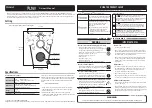
72
5.6.1.
Config / Status and Master/slave configuration
Here you define which MRs are part of the network. Simply
add
the IP-address of the MR. The
Master itself
must
be included (simply check the
itself
box). The IP address of the Master could be
shown as 127.0.0.1 (localhost) or as its own IP address (Figure 5.6.1).
Figure 5.6.1. Subsection dedicated to the configuration of the network.
If the MRs are connected by wire in the same physical network, you use the real IP address (as
shown on the LCD of each MR). If the MRs have a virtual address (VPN address) in addition to the
physical address, you better use the virtual address. Don't forget to check the
Enabled
box and
click on
Apply
.
The column
MRs status
should show ok: this means the Master is able to communicate with the
Slave. The column
Time synced with master
should show
yes.
This means the time difference in
the corresponding MR is less than 3 seconds compared to the Master. This is usually the case if all
MRs have access to a NTP server in the Internet or if a specific MR in the network is acting as time
server. If you have an MR as internal time server, configure all other MRs to use the IP address of
this MR as NTP server. (see chapter 5.3.2).
In the example proposed in Figure 5.6.1, three MRs are connected on the same local network, and
the IP address has been changed manually.
NOTE: the time synchronization might take few minutes to be synchronized at start.
5.6.2.
Common Trigger
Here you define the conditions for a common trigger, named recording in all MRs in the network.
Each line contains a condition, the lines are logically OR combined. A condition might be a single
MR or a group of different MRs. If more than 1 MR is defined, the trigger condition in the single MR
must occur within 3 seconds.










































